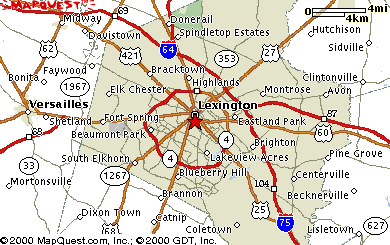     |
LEXINGTON (KY) History When European settlers arrived on the scene, the Bluegrass region was being used as a hunting ground for numerous Native American tribes. Daniel Boone was one of the first Anglo-Saxons to explore the area and helped establish Kentucky's first forts in Harrodsburg and Boonesborough. Lexington was founded in 1775, 17 years before Kentucky became a state. By 1820, it was one of the largest and wealthiest towns west of the Allegheny Mountains. So cultured was its lifestyle, Lexington gained the nickname "Athens of the West." Location Within a day's drive of 75% of the population of the United States, Lexington is strategically located at the intersection of interstates 64 and 75. Lexington is accessible by air with approximately 100 direct and nonstop flights.
Geography Fayette County consists of 283 square miles of gently rolling plateau in the center of the inner Bluegrass Region. The area is noted for its beauty, fertile soil, excellent pastureland and horse and stock farms. Poa Pratensis (bluegrass) thrives on the limestone beneath the soil's surface, playing a major role in the area's scenic beauty and in the development of champion horses. Numerous small creeks rise and flow into the Kentucky River. Population The estimated 2000 population of Lexington-Fayette County was 260,512. The estimated population of the metropolitan statistical area (MSA), which is comprised of Bourbon, Clark, Fayette, Jessamine, Madison, Scott, and Woodford counties, is 424,778. |










